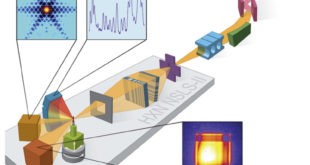Electronics are deeply embedded into the fabric of our society, changing the way we live, work and play while bringing new efficiencies to our global lifestyles, industries, and businesses. We are in the era of the digital economy and ubiquitous connectivity, and the market forces driving data and systems growth …
Read More »Bioelectronics promise more sustainable, biologically produced products including Touch Sensors and Printed Electronics
Bioelectronics is the discipline resulting from the convergence of biology and electronics and it has the potential to significantly impact many areas important to the nation’s economy and well-being, including healthcare and medicine, homeland security, forensics, and protecting the environment and the food supply. It is being fostered by the …
Read More »High gain Antennas including Membrane reflectarray antennas on Small Satellites / Cubesats enable High resolution SmallSat SAR/SIGINT and high capacity communications missions
The small satellite is one of the fast growing sectors in space industries. Small satellites usually refer to satellites below 500 kg, including minisatellite (100–500 kg), microsatellite (10–100 kg), nanosatellite (1–10 kg), picosatellite (0.1–1 kg), and femtosatellite (<0.1 kg). Cube Satellites, aka CubeSats, are a class of nano satellites …
Read More »Nanocoatings for consumer and military electronic devices
Nanotechnology is an industry that has recently begun to offer breakthrough solutions to the world. The incorporation of nanomaterials into thin films, coatings and surfaces leads to new functionalities, completely innovative characteristics and the possibility to achieve multi-functional coatings and smart coatings. The use of nanomaterials also results in performance enhancements …
Read More »Aircraft Antennas Requirements and market growth
Antennas are used for a huge range of applications, from mobile phones and “smart” WiFi-connected appliances to GPS and systems that track aircraft and help pilots land safely. Over the years, several distinct types of antennas have come into common use, with designs, frequencies and operating power levels that depend …
Read More »3D Radars for Counter stealth Aircraft, Counter Unmanned Aircraft Systems (C-UAS) to Air and Missile defence systems
Radar, electromagnetic sensor used for detecting, locating, tracking, and recognizing objects of various kinds at considerable distances. It operates by transmitting electromagnetic energy toward objects, commonly referred to as targets, and observing the echoes returned from them. Energy is emitted in various frequencies and wavelengths from large wavelength radio waves to …
Read More »DARPA JUMP creating next generation microelectronics for dominance in future Battlefield Internet of Things
DARPA pursues game-changing technologies and capabilities in a way that provides a surprising advantage for U.S. and Allied warfighters and at a much faster pace than the state of the art. DARPA’s work with the Services and other agencies aims to meet not just known but as-yet unrecognized needs and …
Read More »DARPA project for cryogenic cables and connectors for quantum computing
Cryogenic electronics is important for a growing number of applications, including superconducting classical computing, superconducting quantum computing and quantum annealing, and superconducting single-photon detector arrays. One of the more difficult aspects about developing a successful superconducting electronics technology at very low temperatures (~10 mK) is the lack of robust commercial …
Read More »DARPA EPIC-HXR developing Hard X-ray imagers
An X-ray, or, much less commonly, X-radiation, is a penetrating form of high-energy electromagnetic radiation. Most X-rays have a wavelength ranging from 10 picometers to 10 nanometers, corresponding to frequencies in the range 30 petahertz to 30 exahertz (30×1015 Hz to 30×1018 Hz) and energies in the range 124 eV …
Read More »New Radiation-hardened electronics enable military small satellites in Low Earth Orbit (LEO) to deep space missions
There has been rapid growth in New Space applications like small satellites (small sats) and Low Earth Orbit (LEO) mega constellations or satellite swarms. The increased U.S. investment in military space is driving growth in classified and unclassified applications. The Satellite has a large number of electronic systems and …
Read More » International Defense Security & Technology Your trusted Source for News, Research and Analysis
International Defense Security & Technology Your trusted Source for News, Research and Analysis









